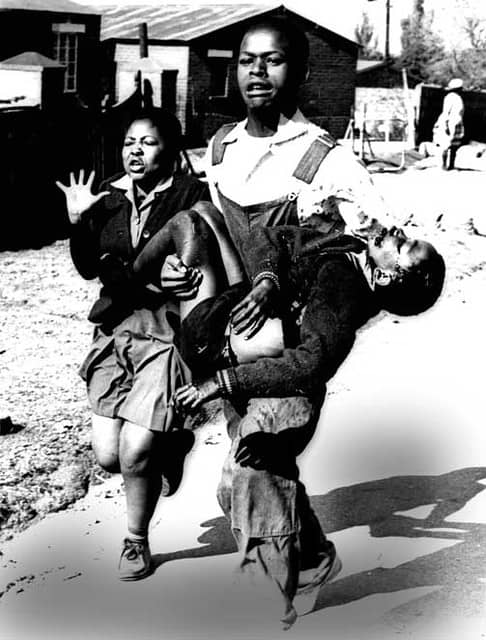
Photograph By the late Masana Samuel “Sam” Nzima on June 16, 1976.Mbuyisa Makhubo carried Hector who was shot in the head by the police while his sister, Antoinette, ran alongside.
By Donald Chakamanga
For me, June 16 holds a personal significance. It is the day of my birth, a day mixed with reflection, sorrow, and celebration. My mind quickly looks back on the June 16, 1976 Soweto uprisings. Sharing a birthday with such a pivotal moment in history has always instilled in me a deep sense of solidarity with the young heroes of Soweto. Their courage and sacrifice have shaped not just South Africa’s history but also my understanding of justice and the power of youth activism.
As a photojournalist, my attention has always been gripped by an image of a 13-year-old Hector Pieterson, whose lifeless body was captured in a photograph by the famous photojournalist Masana Samuel “Sam” Nzima on June 16, 1976. The image shows a perturbed Mbuyisa Makhubo carrying Hector while his sister, Antoinette, runs alongside. Hector was shot in the head by the police and pronounced dead upon arrival at Phellenic clinic. Mbuyisa Makhubo went into exile in 1979; his whereabouts remain unknown. The question still stands: what happened to Mbuyisa Makhubo? Antoinette (Sithole) is alive and is a tour guide at the Hector Pieterson Museum.
According to a BBC News interview, Nzima revealed that “It was a very high risk because this picture was taken under a shower of bullets.” Sam Nzima died in May 2018 at the age of 83. May his soul rest in peace!
Looking back, thousands of black schoolchildren, dressed in their school uniforms, gathered for a peaceful protest against the apartheid regime’s new policy mandating Afrikaans as the medium of instruction in schools. This policy was a direct assault on their right to an equitable education and was seen as a tool of oppression. The children, ranging from primary school pupils to high school students, carried homemade placards with slogans like “Down with Afrikaans” and “We want Bantu education.” The march, organized by the South African Students Movement, was meant to be a peaceful demonstration.
However, the students were met with brutal force by the police. Tear gas filled the air, and soon after, the sound of gunfire rang out. Chaos ensued, and by the end of the day, the streets of Soweto were stained with the blood of young protesters. The Soweto Uprising was not an isolated incident but rather a culmination of growing discontent among South Africa’s black population. The Bantu Education Act of 1953 had already severely limited educational opportunities for black South Africans, relegating them to poorly funded schools and a curriculum designed to prepare them for a life of servitude. The imposition of Afrikaans, a language seen as the oppressor’s tongue, was the final straw.
The bravery of the Soweto children sparked a nationwide wave of protests and strikes. The initial outrage led to sustained resistance, which was met with increasing repression by the apartheid government. Yet, the spirit of defiance ignited by the students’ sacrifice could not be extinguished. The Soweto Uprising became a significant turning point in the struggle against apartheid, demonstrating the power of collective action and the pivotal role of youth in social change.
Decades later, the legacy of the Soweto Uprising continues to resonate. Each year on June 16, the world commemorates African Youth Day, honoring the students who stood up against oppression and highlighting the ongoing fight for education equity. The Hector Pieterson Museum in Soweto stands as a poignant reminder of the events of that day and the sacrifices made in the name of freedom.
While South Africa has made significant strides since the end of apartheid, challenges remain. Education inequality persists, with many schools still under-resourced and students facing barriers to quality education. The ideals that fueled the Soweto Uprising – justice, equality, and the right to education – continue to drive efforts towards a more inclusive and equitable society.
As the world celebrates the Day of the African Child, we are reminded of the importance of investing in education for all children. In a similar vein, UNICEF has issued a stark warning about the future of education on the African continent. The international body calls for urgent action to address a severe education financing gap that threatens to undermine the potential of a whole generation.
According to UNICEF, nearly half a century after the Soweto uprising, where students fought for their educational rights, the battle for accessible, quality education in Africa continues. By 2050, the continent is expected to be home to one billion children. However, without significant investment, the existing lack of educational funding could have catastrophic consequences for both the youth and the region’s economic stability.
“Children have the right to quality education, but education systems are failing far too many of them,” said UNICEF Regional Director for Eastern and Southern Africa, Ms. Etleva Kadilli. She added, “To ensure prosperity in Africa, we urgently need to see a continental revolution where commitments are turned into concrete action so children can attain the vital foundational skills necessary for them to progress to higher forms of education and realize their full potential.”

